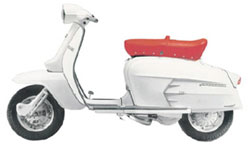Lambretta Model 200 SX

200 SX SpecificationsYears produced: 1966 - 1968Amount produced: 20,783 Engine: 1 cylinder, air cooled 2-stroke Induction: piston ported Bore: 66 mm Stroke: 58 mm Cubic capacity: 198 cc Compression ratio: 8.0:1 BHP at rpm: 11 @ 5500 Transmission: 4 speed constant mesh Lubrication: 2% Carburetor: Dellorto SH1/20 Ignition: contact breaker & points Ignition timing: 23 degrees BTDC Breaker gap: 0.35-0.45 mm Voltage: 6 volt Wheel size: 10" Tire size: 3.50 x 10 Max speed: 60 mph Total dry weight: 242 lbs |
LAMBRETTA MODEL 200 SX HISTORY
Following the positive experience of the Lambretta 200 TV on foreign markets, Innocenti decided to try the same size scooter on the Italian market. The new version would be essentially the same but would have the new name 200 X Special. Compared to its predecessor, the 200 TV, the Lambretta side panels were more square shaped and carried a polished aluminum arrow with the size of the engine written on it. For the first time on an Innocenti motorscooter, the saddle was "cardinal red".
The characteristics of the motor, however, remained unchanged. The power stayed at eleven horsepower and the maximum speed was 107 km/h, both aspects contributed to its road handling, which made the scooter much safer.
The Lambretta 200 X Special was the fastest and most-powerful scooter on the market. Thanks to its excellent road handling and braking power, it soon became the preferred means of transportation to the legions of sporting scooterists that participated in time trials and acceleration rates.
Unfortunately, its high price of more than 190,000 Italian lira considerably limited the amount of people who could afford it. In its three years of production, only 20,783 units were built, and most of those ended up in England.
For the Italian market, the 200 XS was offered only in white, while for foreign markets different versions were available. In England, for example, one part of the side panels was painted "intense green" or other lively shades.
As with its little sister, one of the esthetic changes which occurred was the substitution of the front plastic coat-of-arms with a rectangular one made of chromed metal.
